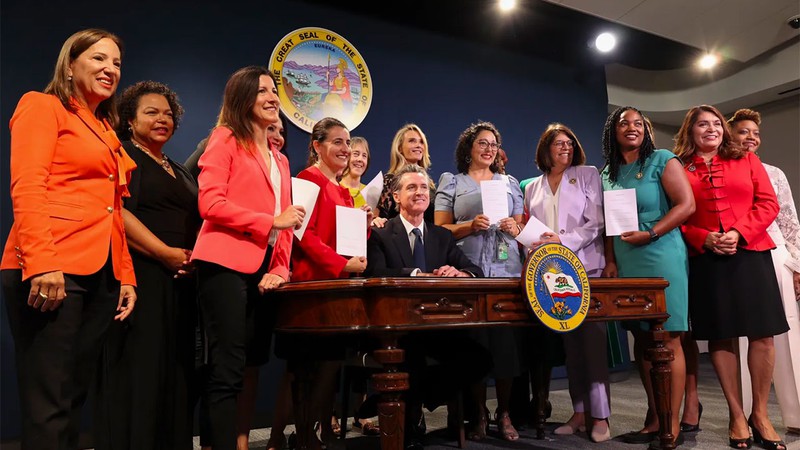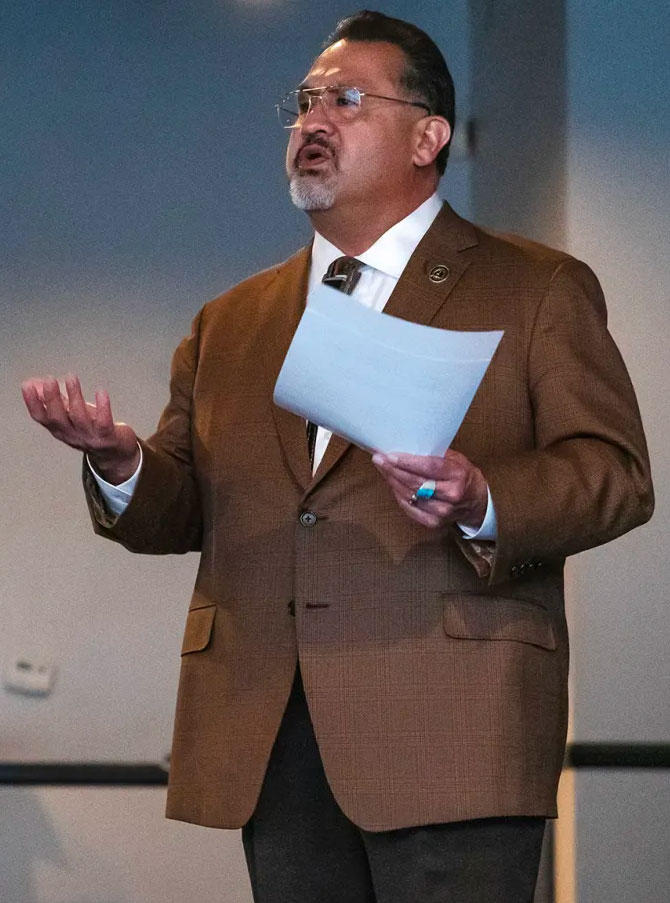Problem Solvers Caucus looks to put policy before politics.

In a photo posted on social media, Gov. Gavin Newsom poses with members of the California Legislative Women’s Caucus after signing a series of bills.
BY SAMEEA KAMAL, CalMatters
Every other week, the 21 members of the Problem Solvers Caucus gather for lunch to hear presentations on different policies. This session, they’re focusing on clean energy and homelessness—issues they say impact every legislative district in California.
Inspired by a similar group in Congress, the caucus is an experiment—made up of both Democrats and Republicans, assemblymembers and state senators—with the goal of creating a “neutral space” that puts policy before politics.
Launched in 2021 by then-Assemblymembers Adam Gray, a Democrat from Merced, and Jordan Cunningham, a Republican from San Luis Obispo, and Chad Mayes, the only independent legislator last session, the caucus includes equal numbers of Republicans and Democrats, as well as proportional Assembly and Senate representation, according to Sen. Josh Newman, a co-chairperson and Democrat from Brea.
That structure—different from even other bipartisan caucuses—is designed to make it truly impartial. One condition of membership: No one can actively work against another member’s bill.
While it has a fundraising arm, the Problem Solvers’ focus is not on supporting causes or candidates, but on bringing in more “smart people,” Newman said.
Those presentations have already helped Assemblymember Carlos Villapudua think more about the fiscal impact of bills, said the Democrat from Stockton and another of the four co-chairpersons.
“You think of a bill—of what it does, and it may be really, really good,” he said. “But … it opens up my eyes more to look not just at the bill, but spend a lot more time on the fiscal part—like what is the cost of the bill? … Is it coming out of the general fund? Is it going to be a tax? So it really brings more awareness.”
Despite the policy focus, the caucus also has its political benefits. Sen. Scott Wilk, a caucus member from Lancaster who finished two years as Senate Republican leader in December, sees it as a way for Republicans to stay in the game.
“Based on the policy that’s coming out of the Legislature, it’s pretty clear the progressives are getting their way,” he said. “So what can I do to be relevant and positively affect the lives of 40 million Californians? I think the best—the only—hope is the Problem Solvers.”
It’s not the only caucus trying to make a difference in the Legislature. These alliances of lawmakers, who form along issues or identities, are a way to gather support for their own bills and present a united front on shared interests, including proposals that cater to different demographic groups.
On their own, the caucuses don’t enact laws. But some do have influence over what gets prioritized and passed. Lawmakers say the caucuses help them form relationships and decide on issues, even changing their minds.
“Caucuses can be pretty influential. One of the reasons is they can help set the agenda,” said Christian Grose, director of USC’s Schwarzenegger Institute for State and Global Policy. “They have an ability to bring things up in sort of complementary times with the leadership, sometimes in conflict with the leadership. It’s a way to percolate ideas.”
The Benefits of Membership
Besides the four party caucuses, there are 16 official caucuses listed on the Assembly and Senate websites. In the Assembly, for a caucus to formally exist, it must be recognized by the speaker. In the Senate, they don’t require recognition by the president pro tem.
While the number of caucuses hasn’t changed dramatically, veteran lobbyist Chris Micheli said that as the ranks of some caucuses have grown, so has their power.
The now 12-member Legislative Black Caucus was the first, established in 1967, followed by the now 35-member Latino Caucus in 1973. There’s also a Women’s Caucus (now with a record 50 members), an LGBTQ Caucus (12 legislators), a Rural Caucus, a Mental Health Caucus (15 members), even an Aviation Caucus (21 members).
Some caucuses meet every two weeks. Some haven’t met for years, but still take in new members. Some have died out, while others exist in name only, once their active members term out.
Lawmakers say caucuses help them understand which bills are important. Caucuses have their own staff, which, for larger caucuses, outnumber each legislator’s staff and can help members weed through the thousands of bills each session.
Caucuses can also be beneficial in helping to grow the ranks of a particular group. The California Legislative Black Caucus, for example, runs a leadership training program to increase representation at all levels of state government.
The Legislative Native American Caucus formed in 2021 after the election of Assemblymember James Ramos, a Democrat from Highland, as the first and only Native American legislator, to amplify issues important to tribes across California.

At their meeting last week at a restaurant near the Capitol, the 56-member caucus discussed plans for a series of events in May to raise awareness about missing and murdered indigenous women, including a select committee hearing to talk about concerns with a federal law that addresses criminal activity jurisdiction on tribal lands.
In a statement, Ramos said that the caucus informs legislators and the public “about Native American issues, culture and tribal-related legislation.” By sponsoring Missing and Murdered Indigenous People Week and California Indian Cultural Awareness Day, the caucus “increases the visibility and knowledge about the diversity of California’s tribes,” he added.
The Native American Caucus is among several that are bipartisan and include Republican members. Others are bipartisan according to their bylaws, but only have Democratic members.
Still, caucuses give Republicans, who are vastly outnumbered in the Legislature, another avenue for influence. Otherwise, they can usually only get their way when enough moderate Democrats join them, as happened on April 20 when Assembly Republicans demanded a special hearing on bills to address the fentanyl crisis.
But GOP influence depends on the caucus. In the Legislative Women’s Caucus, for example, the eight Republicans are even more outnumbered by 42 Democrats, compared to the overall partisan breakdown among women in the Legislature. That means on issues such as abortion rights, which the Women’s Caucus has prioritized since the U.S. Supreme Court overturned the Roe decision last June, there isn’t always universal agreement.
Sen. Janet Nguyen, a Republican from Huntington Beach and the Senate’s Minority Caucus chairperson, said she doesn’t always agree with the positions taken by the Women’s Caucus, including on abortion. But she sees value in the opportunity to make women’s issues prominent.
Nguyen has been able to find more allies on her bills in the Asian American and Pacific Islander Caucus.
“I’ve found that the AAPI caucus—especially under the leadership of the current chair, Evan Low—they make every effort to be bipartisan. He’s made it a priority to work across the aisle,” she said. “He understands that we don’t always can’t get along. But you know, when we can, we do.”
Bipartisan caucuses offer a benefit for supermajority Democrats, as well, giving them a chance to tout working across the aisle, since caucuses can serve as branding tools to voters and donors.
That could prove beneficial in a political environment where despite the partisan extremes, most Californians report being politically in the “middle-of-the-road,” according to a February survey by the Public Policy Institute of California.
But Assemblymember Alex Lee, who is also vice-chairperson of the 30-member Progressive Caucus, says its influence is a reflection of a “deeper blue” state. “More people care about universal healthcare, education, housing—things that are very economically sort of equal,” he said.
What About Partisan Caucuses?
The identity and interest-based groups are distinct from the better-known party caucuses, which wield far more power, especially for Democrats, who hold supermajorities in both the Assembly and Senate.
Just ask Assemblymember Jasmeet Bains.
Last month, the Democrat who represents oil-dependent Bakersfield was the sole Assemblymember of her party to vote against a bill to amp up oversight of the industry and to potentially cap profits. While some other moderate Democrats abstained from voting, Bains celebrated her dissent, tweeting with #StandAlone.
Soon after, Assembly Speaker Anthony Rendon, the leader of the Democratic caucus, booted her off the Business and Professions Committee. While she’ll still get to vote yes or no on bills out of the committee on the Assembly floor, she won’t get as much of a chance to shape them.
There are also unofficial caucuses within parties—notably moderate Democrats who have aligned along shared pro-business outlooks to defeat or water down bills.
On the Republicans’ side, their smaller Assembly and Senate caucuses are active and united on bill votes and priorities. Most recently, for example, Senate Republicans came together to issue a letter to the California Public Utilities Commission about their concerns with a “fixed-charge” electricity price proposal.
Sarah Anderson, a political science professor at the University of California, Santa Barbara, said the power of a caucus, other than its size, depends on how polarized the parties are, and how close the votes might be on a particular measure.
“If the caucus can come together to make collective demands on their own party, then that is potentially still powerful.”
Making Their Own Rules
Caucuses aren’t subject to the same open meeting and public record laws as other state and local public bodies. They are also permitted to meet in closed session if they’re all members of the same party.
But even some that are bipartisan aren’t open to the public, such as the Problem Solvers Caucus. That gives lawmakers a space to have “frank conversation,” Wilk said.
There are also no standard rules on membership. That’s why the Latino Caucus, which recently celebrated its 50th anniversary, came under fire once again for not allowing Republican lawmakers to join.
Assemblymember Sabrina Cervantes, a Corona Democrat and caucus chairperson, told the Sacramento Bee that the caucus advocates for “the nearly 16 million Latinos in California,” and would “continue as our founding memberships’ precedent set forth.”
That’s permitted, since each caucus has its own bylaws and enforcement. There are also no overarching rules on how caucuses can spend their money, according to the Fair Political Practices Commission.
In fact, there are some perks: Caucuses typically have nonprofit arms, and while California law caps the amount donors can contribute to politicians’ campaigns, donations to these nonprofit foundations are unlimited and have fewer disclosure requirements.
As a CalMatters investigation found, much of the money comes from corporations and labor unions with business before the Legislature. The cash is typically spent on events or on trips that might provide access to lawmakers from specific interests.
In 2022, the second biggest sponsor of legislators’ travel was the Legislative Jewish Caucus, which spent about $231,000 (about one fifth of all spending on sponsored trips that year) to take 14 legislators to Israel. The Latino Caucus ranked fifth with about $25,000, according to a CalMatters analysis of financial disclosure forms filed by legislators.
In 2021, the Problem Solvers Caucus Foundation ranked third in travel spending, with nearly $23,000.
CalMatters data journalist Jeremia Kimelman contributed to this report.
Visit CalMatters to read the full-length article, “Across the aisle: Can bipartisan caucuses change the California Legislature?” CalMatters.org is a nonprofit, nonpartisan media venture explaining California policies and politics.
Articles which extol the virtues of a report or article put out by a local newsroom.